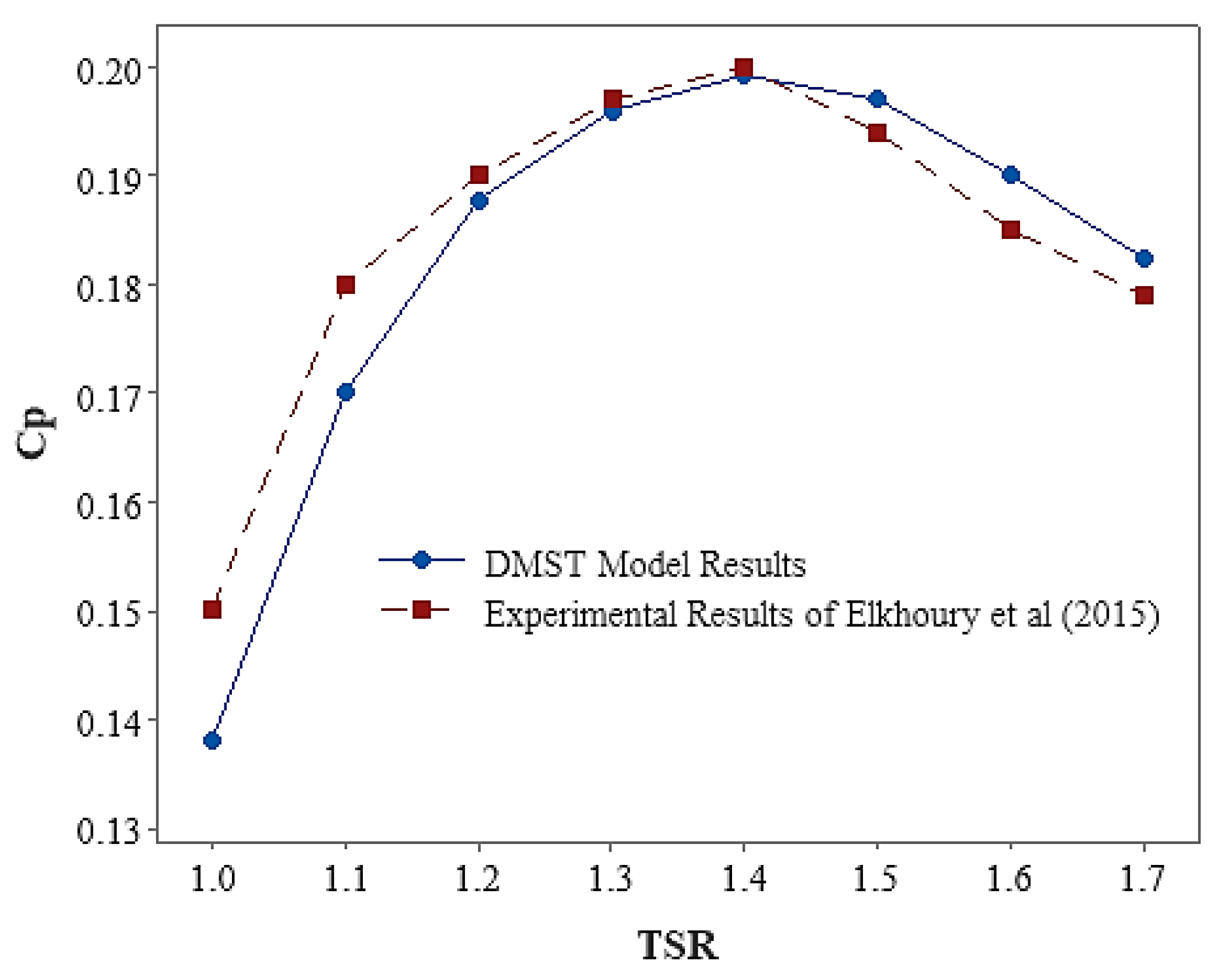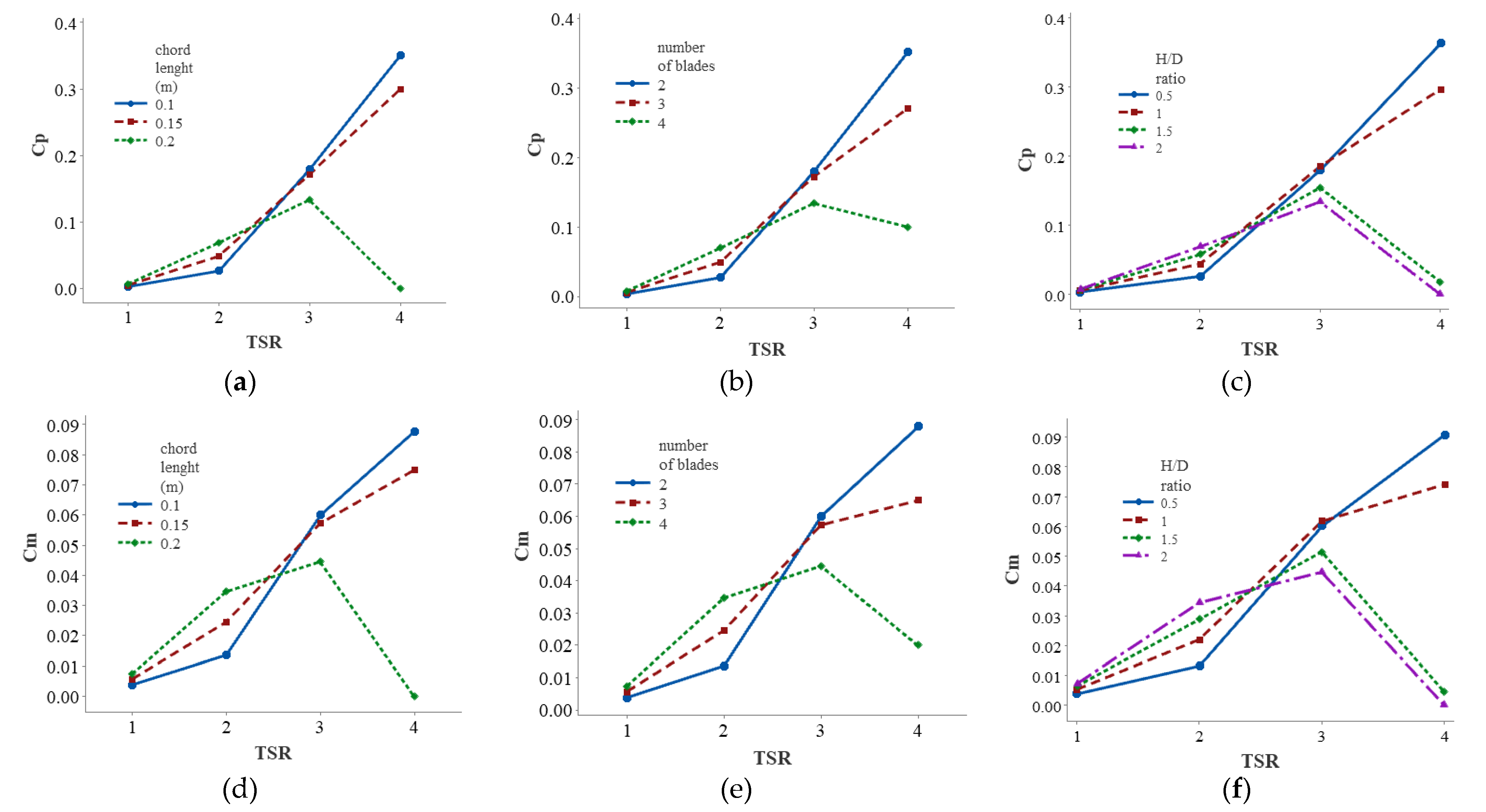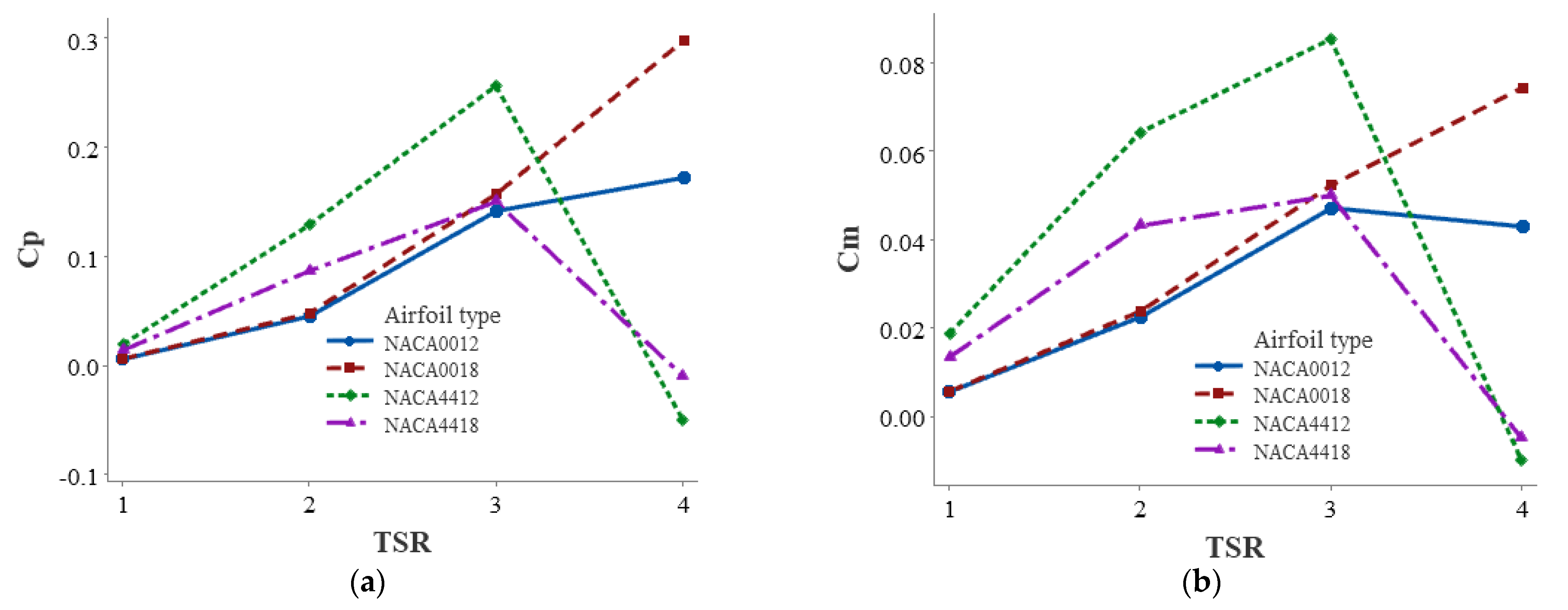Analytical Study of the Impact of Solidity, Chord Length, Number of Blades, Aspect Ratio and Airfoil Type on H-Rotor Darrieus Wind Turbine Performance at Low Reynolds Number
Abstract
:1. Introduction
2. Materials and Methods
2.1. Turbines
2.2. Double Multiple Stream Tube (DMST) Model
2.3. Model Validation
3. Results
3.1. Design Parameters
3.2. Airfoil Type Effect
3.3. Effects of Blade Solidity on Turbine Performance
4. Conclusions
- Longer chords length for wind turbines can provide higher power and momentum coefficients at lower blade tip speeds, but at higher blade tip speeds this is detrimental. This is the case in all four selected airfoil types.
- At low blade speeds, more blades can solve the problems of self-rotation and low momentum; however, this is a negative factor at high blade speeds.
- Except for the NACA4412 airfoil, the maximum power coefficient of the turbine with H/D ratio of 1 is greater than in the other cases, and the maximum power coefficient was achieved with H/D ratio of 0.5 in the NACA4412 airfoil.
- Among symmetrical and asymmetrical airfoils, NACA4412 outperformed others.
- Increased blade solidity had a less positive effect on turbine performance at low blade tip speeds and a negative effect at high blade tip speeds.
Author Contributions
Funding
Data Availability Statement
Conflicts of Interest
Appendix A
| c: | blade chord length |
| Cd: | drag coefficient |
| Cl: | lift coefficient |
| Cn: | normal aerodynamic force coefficient |
| Cp: | power coefficient of the wind turbine |
| Ct: | tangential aerodynamic force coefficient |
| D: | diameter of the rotor |
| Fn: | aerodynamic tangential force |
| H: | blade length |
| N: | N number of the blades |
| R: | rotor radius |
| Re: | Reynolds number |
| t: | time |
| T: | torque |
| W: | wake velocity |
| U: | axial induction factor |
| V∞: | free wind velocity |
| Ve: | equilibrium wind velocity in upstream |
| V’: | downstream velocity |
| Vc | chordal velocity component |
| Vn: | normal velocity component |
| Greek letters | |
| αl: | angle of attack for λ < 1 |
| αu: | angle of attack for λ ≥ 1 |
| θ: | azimuthal angle |
| Ӫ: | rotational acceleration of rotor |
| λ: | blade tip speed ratio |
| ρ: | density of air |
| σ: | rotor solidity |
| ω: | rotational speed of rotor |
References
- Firdus, R.; Kiwata, T.; Kono, T.; Nagao, K. Numerical and experimental studies of a small vertical-axis wind turbine with variable-pitch straight blades. J. Fluid Sci. Technol. 2015, 10, JFST0001. [Google Scholar] [CrossRef] [Green Version]
- Armstrong, S.; Fiedler, A.; Tullis, S. Flow separation on a high Reynolds number, high solidity vertical axis wind turbine with straight and canted blades and canted blades with fences. Renew. Energy 2012, 41, 13–22. [Google Scholar] [CrossRef]
- Rezaeiha, A.; Kalkman, I.; Blocken, B. Effect of pitch angle on power performance and aerodynamics of a vertical axis wind turbine. Appl. Energy 2017, 197, 132–150. [Google Scholar] [CrossRef] [Green Version]
- Abraham, J.P.; Plourde, B.D.; Mowry, G.S.; Minkowycz, W.J.; Sparrow, E.M. Summary of Savonius wind turbine development and future applications for small-scale power generation. J. Renew. Sustain. Energy 2012, 4, 042703. [Google Scholar] [CrossRef]
- Zemamou, M.; Aggour, M.; Toumi, A. Review of savonius wind turbine design and performance. Energy Procedia 2017, 141, 383–388. [Google Scholar] [CrossRef]
- Singh, M.; Biswas, A.; Misra, R. Investigation of self-starting and high rotor solidity on the performance of a three S1210 blade H-type Darrieus rotor. Renew. Energy 2015, 76, 381–387. [Google Scholar] [CrossRef]
- Sun, X.; Zhu, J.; Hanif, A.; Li, Z.; Sun, G. Effects of blade shape and its corresponding moment of inertia on self-starting and power extraction performance of the novel bowl-shaped floating straight-bladed vertical axis wind turbine. Sustain. Energy Technol. Assess. 2020, 38, 100648. [Google Scholar] [CrossRef]
- Beri, H.; Yao, Y. Effect of Camber Airfoil on Self-Starting of VAWT. J. Environ. Sci. Technol. 2011, 4, 302–312. [Google Scholar] [CrossRef] [Green Version]
- Islam, M.; Fartaj, A.; Carriveau, R. Design analysis of a smaller-capacity straight-bladed VAWT with an asymmetric airfoil. Int. J. Sustain. Energy 2011, 30, 179–192. [Google Scholar] [CrossRef]
- Danao, L.A.; Qin, N.; Howell, R. A numerical study of blade thickness and camber effects on vertical axis wind turbines. Proc. Inst. Mech. Eng. Part A J. Power Energy 2012, 226, 867–881. [Google Scholar] [CrossRef]
- Tirandaz, M.R.; Rezaeiha, A. Effect of airfoil shape on power performance of vertical axis wind turbines in dynamic stall: Symmetric Airfoils. Renew. Energy 2021, 173, 422–441. [Google Scholar] [CrossRef]
- Wang, Y.; Shen, S.; Li, G.; Huang, D.; Zheng, Z. Investigation on aerodynamic performance of vertical axis wind turbine with different series airfoil shapes. Renew. Energy 2018, 126, 801–818. [Google Scholar] [CrossRef]
- Li, Q.; Maeda, T.; Kamada, Y.; Murata, J.; Furukawa, K.; Yamamoto, M. Effect of number of blades on aerodynamic forces on a straight-bladed Vertical Axis Wind Turbine. Energy 2015, 90, 784–795. [Google Scholar] [CrossRef]
- Du, L.; Ingram, G.; Dominy, R.G. Experimental study of the effects of turbine solidity, blade profile, pitch angle, surface roughness, and aspect ratio on the H-Darrieus wind turbine self-starting and overall performance. Energy Sci. Eng. 2019, 7, 2421–2436. [Google Scholar] [CrossRef] [Green Version]
- Beri, H.; Yao, Y. Double Multiple Streamtube Model and Numerical Analysis of Vertical Axis Wind Turbine. Energy Power Eng. 2011, 3, 262–270. [Google Scholar] [CrossRef] [Green Version]
- Ghiasi, P.; Najafi, G.; Ghobadian, B.; Jafari, A. Analytical and Numerical Solution for H-type Darrieus Wind Turbine Performance at the Tip Speed Ratio of Below One. Int. J. Renew. Energy Dev. 2020, 10, 269–281. [Google Scholar] [CrossRef]
- Paraschivoiu, I.; Delclaux, F. Double multiple streamtube model with recent improvements (for predicting aerodynamic loads and performance of Darrieus vertical axis wind turbines). J. Energy. 2012, 3, 250–255. [Google Scholar] [CrossRef]
- Moghimi, M.; Motawej, H. Developed DMST model for performance analysis and parametric evaluation of Gorlov vertical axis wind turbines. Sustain. Energy Technol. Assessments 2020, 37, 100616. [Google Scholar] [CrossRef]
- Saeidi, D.; Sedaghat, A.; Alamdari, P.; Alemrajabi, A.A. Aerodynamic design and economical evaluation of site specific small vertical axis wind turbines. Appl. Energy 2013, 101, 765–775. [Google Scholar] [CrossRef]
- Muthukumar, P.; Sarkar, D.K.; De, D.; De, C.K. Innovations in Sustainable Energy and Technology. In Advances in Sustainability Science and Technology; Springer: Singapore, 2021. [Google Scholar] [CrossRef]
- Paraschivoiu, I. Double-multiple streamtube model for studying vertical-axis wind turbines. J. Propuls. Power 1988, 4, 370–377. [Google Scholar] [CrossRef]
- Saber, H.E.; Attia, E.M.; El Gamal, H.A. Analysis of Straight Bladed Vertical Axis Wind Turbine. Int. J. Eng. Res. Technol. 2015, 4, 714–723. [Google Scholar]
- Ahmadi-Baloutaki, M. Analysis and Improvement of Aerodynamic Performance of Straight Bladed Vertical Axis Wind Turbines. ProQuest Dissertations and Theses. Ph.D. Thesis, University of Windsor, Windsor, ON, Canada, 2016; 196p. Available online: https://ui.adsabs.harvard.edu/abs/2016PhDT........10A/abstract (accessed on 23 February 2016).
- Sumantraa, R.B.; Chandramouli, S.; Premsai, T.P.; Prithviraj, P.; Vivek, M.; Kishore, V.R. Numerical analysis of effect of pitch angle on a small scale vertical axis wind turbine. Int. J. Renew. Energy Res. 2014, 4, 929–935. [Google Scholar] [CrossRef]
- Elkhoury, M.; Kiwata, T.; Aoun, E. Experimental and numerical investigation of a three-dimensional vertical-axis wind turbine with variable-pitch. J. Wind Eng. Ind. Aerodyn. 2015, 139, 111–123. [Google Scholar] [CrossRef]
- Bogateanu, R.; Dumitrache, A.; Dumitrescu, H.; Stoica, C.I. Reynolds number efects on the aerodynamic performance of small VAWTs. UPB Sci. Bull. Ser. D Mech. Eng. 2014, 76, 25–36. [Google Scholar]
- Subramanian, A.; Yogesh, S.A.; Sivanandan, H.; Giri, A.; Vasudevan, M.; Mugundhan, V.; Velamati, R.K. Effect of airfoil and solidity on performance of small scale vertical axis wind turbine using three dimensional CFD model. Energy 2017, 133, 179–190. [Google Scholar] [CrossRef]
- Rezaeiha, A.; Montazeri, H.; Blocken, B. Towards optimal aerodynamic design of vertical axis wind turbines: Impact of solidity and number of blades. Energy 2018, 165, 1129–1148. [Google Scholar] [CrossRef]
- Jafari, M.; Razavi, A.; Mirhosseini, M. Effect of airfoil profile on aerodynamic performance and economic assessment of H-rotor vertical axis wind turbines. Energy 2018, 165, 792–810. [Google Scholar] [CrossRef]
- Eboibi, O.; Danao, L.A.; Howell, R.J. Experimental investigation of the influence of solidity on the performance and flow field aerodynamics of vertical axis wind turbines at low Reynolds numbers. Renew. Energy 2016, 92, 474–483. [Google Scholar] [CrossRef]
- Posa, A. Influence of Tip Speed Ratio on wake features of a Vertical Axis Wind Turbine. J. Wind Eng. Ind. Aerodyn. 2019, 197, 104076. [Google Scholar] [CrossRef]
- Islam, M.; Ting, D.; Fartaj, A. Aerodynamic models for Darrieus-type straight-bladed vertical axis wind turbines. Renew. Sustain. Energy Rev. 2008, 12, 1087–1109. [Google Scholar] [CrossRef]













Publisher’s Note: MDPI stays neutral with regard to jurisdictional claims in published maps and institutional affiliations. |
© 2022 by the authors. Licensee MDPI, Basel, Switzerland. This article is an open access article distributed under the terms and conditions of the Creative Commons Attribution (CC BY) license (https://creativecommons.org/licenses/by/4.0/).
Share and Cite
Ghiasi, P.; Najafi, G.; Ghobadian, B.; Jafari, A.; Mazlan, M. Analytical Study of the Impact of Solidity, Chord Length, Number of Blades, Aspect Ratio and Airfoil Type on H-Rotor Darrieus Wind Turbine Performance at Low Reynolds Number. Sustainability 2022, 14, 2623. https://doi.org/10.3390/su14052623
Ghiasi P, Najafi G, Ghobadian B, Jafari A, Mazlan M. Analytical Study of the Impact of Solidity, Chord Length, Number of Blades, Aspect Ratio and Airfoil Type on H-Rotor Darrieus Wind Turbine Performance at Low Reynolds Number. Sustainability. 2022; 14(5):2623. https://doi.org/10.3390/su14052623
Chicago/Turabian StyleGhiasi, Pedram, Gholamhassan Najafi, Barat Ghobadian, Ali Jafari, and Mohamed Mazlan. 2022. "Analytical Study of the Impact of Solidity, Chord Length, Number of Blades, Aspect Ratio and Airfoil Type on H-Rotor Darrieus Wind Turbine Performance at Low Reynolds Number" Sustainability 14, no. 5: 2623. https://doi.org/10.3390/su14052623






